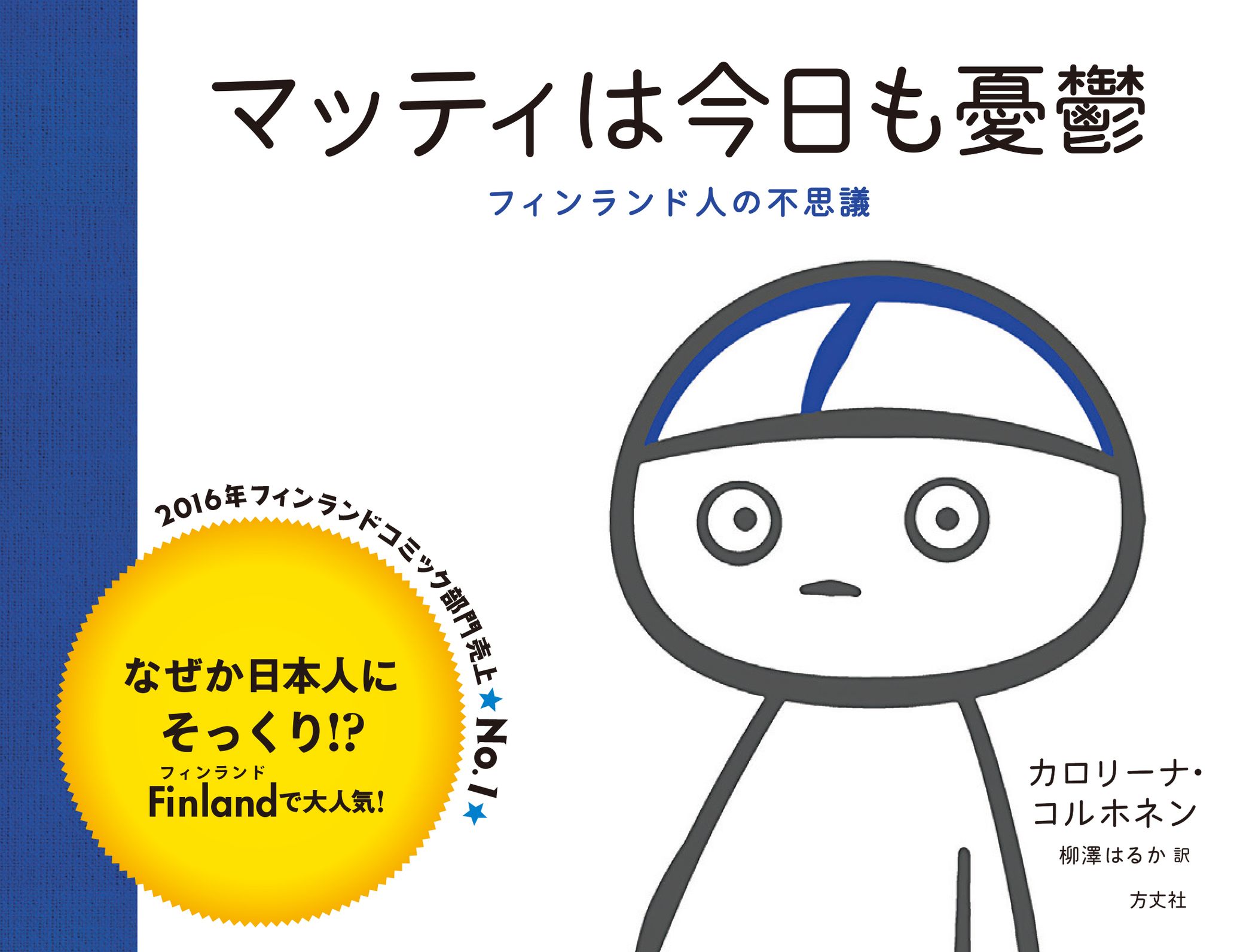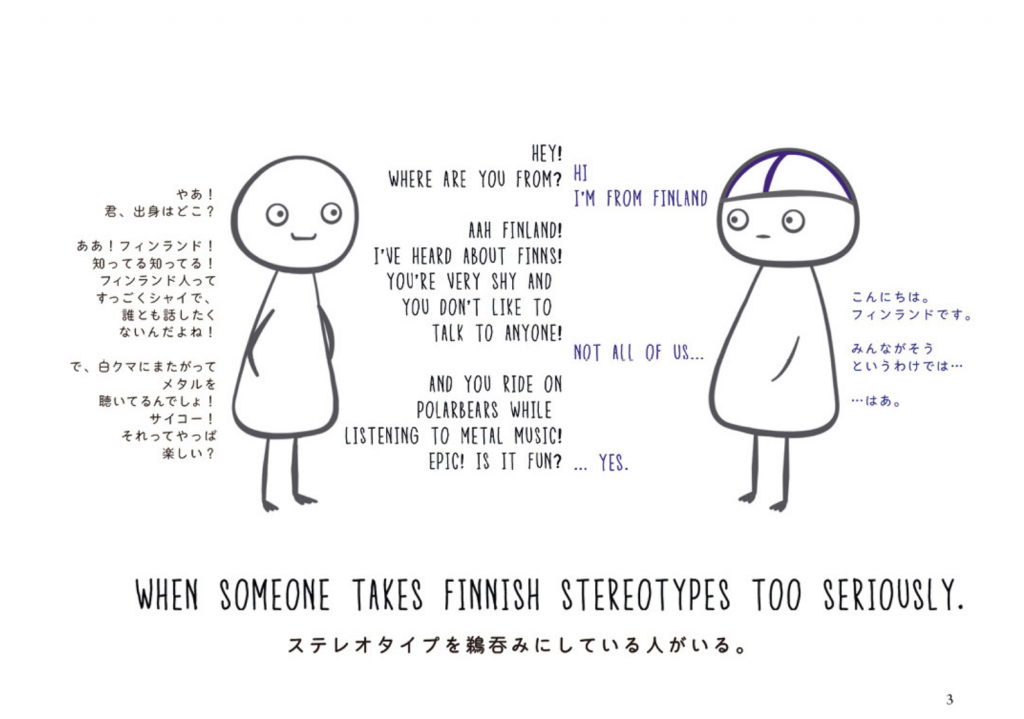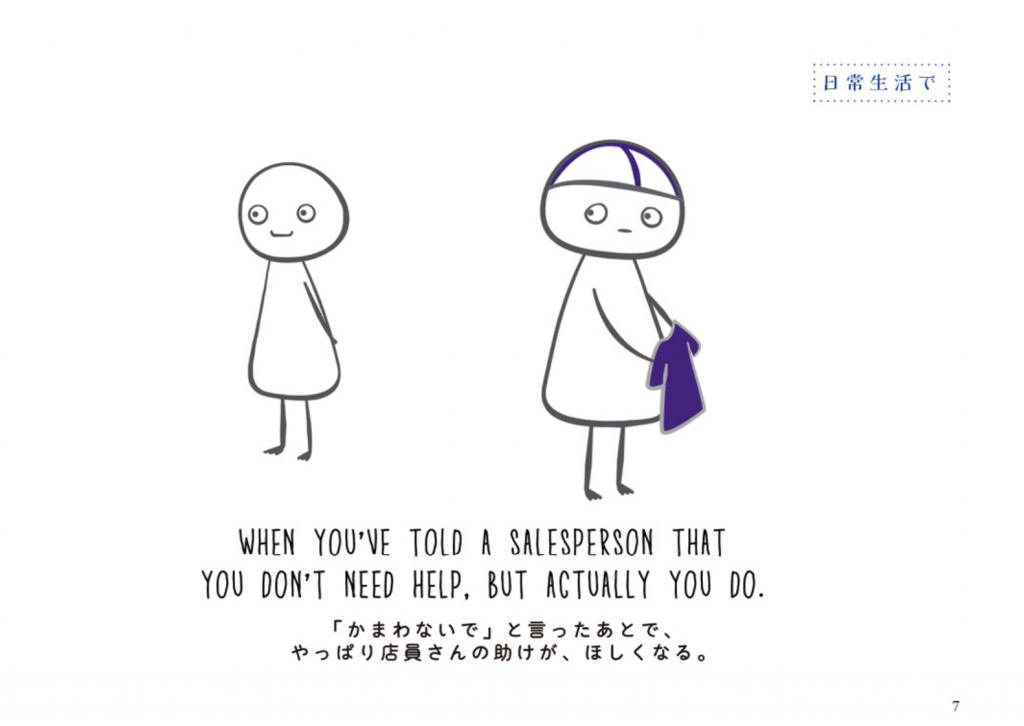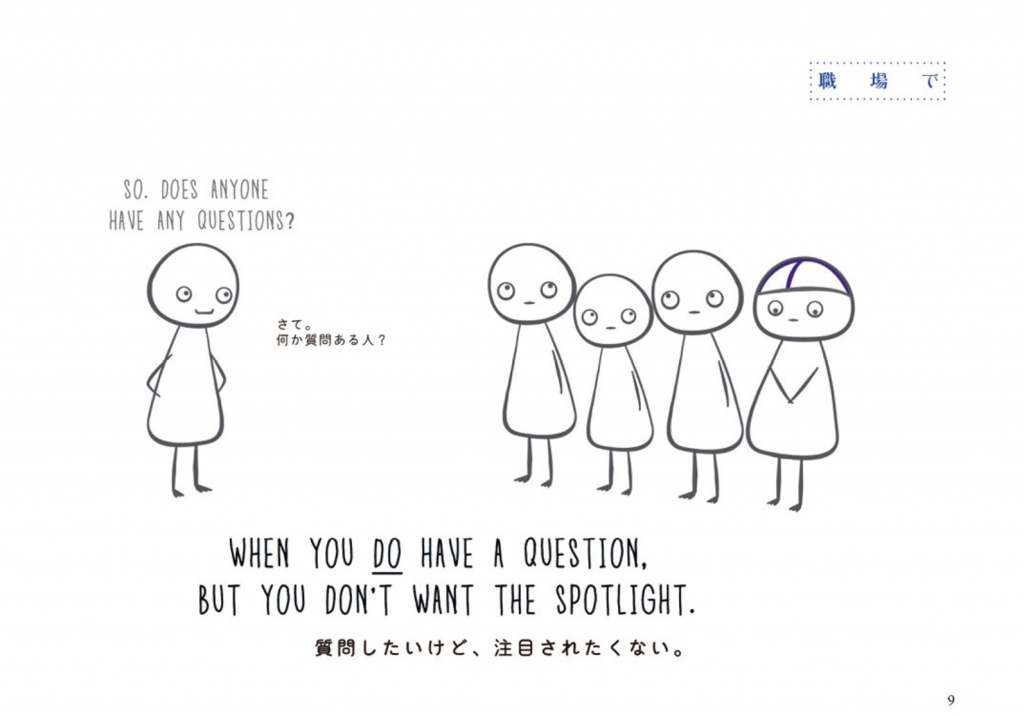For four years in a row, Finland is the top runner on the World Happiness Report. However, that does not mean that the Finns don’t have nightmares. The Finnish designer Karoliina Korhonen created a comic series Finnish Nightmares, which features a stick figure protagonist Matti. Matti is reserved, slightly socially awkward, and enjoys being alone. The comics portray the daily dilemma that Matti faces in different situations, perhaps, to keep other Finnish people happy. In 2016, Finnish Nightmares was translated into Japanese. Matti or the Finnish way of life struck a chord with the Japanese readers and gained faithful followers. The comic series has also been translated into Chinese, English and other European languages. Her third book in Japanese, which features Finnish proverbs and sayings, was published recently. This is Karoliina’s first interview with a Japanese media outlet. I asked her about how she felt about the Matti’s popularity in Japan and her views on Finnish happiness.
“Matti” expresses a lot of my own experiences.
−−In 2015, you started your website Finnish Nightmares and created the character Matti. Both became very popular in 2016. Can you tell us about your career before you launched the website?
Karoliina Korhonen: I have been working as a UI designer and a graphic designer. I am keeping my day job and working on Matti in my free time.
−−How did you create Matti? I heard Matti is a common male name in Finland. Is there a reason that you chose that particular name and why did you decide to have a male character?
Korhonen: I started out drawing a stick figure, and I didn’t have a name or a gender for it. I created the figure so that I could explain to my European friends about awkward situations for stereotypical Finns.
The most common Finnish name is Kari. Matti is the second most common name. I didn’t feel that the character looked like Kari for some reason and I named the character Matti. I was not thinking about the gender specifically as the stereotypes and situations portrayed in the comics are universal for both genders.
−−How much of your own thoughts are reflected in Matti’s words?
Korhonen: A lot. Every Matti comic that I draw is related to something that happened to me personally. My followers and other people, who don’t know me very well, get to learn certain types of experiences that I encounter in my daily life. They are definitely the Finnish nightmares.
−−By creating Finnish Nightmares did you discover anything new about your own country’s culture that you did not know before?
Korhonen: I learned a lot of things. Not all Finns are like Matti. Someone would say, “I know someone who acts like this, but not me.” It was refreshing to get people’s feedback. It was a good lesson for me to learn about my own country.
A Good Way to Learn Finnish
−−You just published a new book in Japan last month, the third book in the Matti series based on Finnish proverbs. What is your inspiration for creating this particular book?
Korhonen: I always enjoyed weird proverbs and sayings in Finnish and other languages. And, when you don’t know that it’s a proverb, it could sound very odd. For example, there is a Finnish saying, “It’s like a fist in the eye”. It actually means something fits like a glove or something fits perfectly. If you don’t know the meaning, it sounds quite odd and brutal. That is why I wanted to translate them into English. Nowadays, Finnish Nightmares is used frequently in schools to teach Finnish and Finnish culture. I think the proverbs are a cool way to learn Finnish.
−−You visited China in 2018 and interacted with many local university students. One of the students indicated that his impression of Matti’s communication style and cultural features were similar to that of China and Finland. Also, many people in Japan seem to connect with Matti —Some Japanese readers say when they feel depressed and read Finnish Nightmares, it actually helps them to cope and to heal. In your experience, have you found any similarities, in reaction and opinion, from other Asian countries?
Korhonen: I have only been in China and would like to visit Japan and South Korea one day. What I learned is that how we communicate is eerily similar. We have our cultural differences. In Asian countries, there is a lot of bowing. You have body language that demonstrates respect. In Finland, respect comes from distance. We keep a distance to show respect—physical and even mental distance with others. For example, we don’t push ourselves to other people and refrain from asking too many questions. The baseline of our communication is eerily similar; how we speak to each other, how many words we use, and what kind of words we use.
−−Do you know that Matti is very popular in Japan?
Korhonen: I have heard from the publisher. I would like to visit Japan one day. And I don’t expect Matti to be on billboards or anything, but I would just like to visit bookshops and meet with people who like Matti.
−−British writer Richard D. Lewis and others have analyzed that “the Finnish dilemma is that they cloak their Western values in an Asian communication style”. What do you think?
Korhonen: I am not an expert on Western values, and I just have my personal experience with the Finnish culture. I think the Finns have their own values, which is similar or closer to the Japanese values. We do belong to the European Union and we are Europeans, but we are not that Western overall. We have our own little thing going on here in Finland.
(Soshishya)Karoliina Korhonen, Haruka Yanagisawa(Translation)
Feeling of safety, freedom and being able to trust people around you make you happy
—Lately, the Finnish concept of sisu (the ability to endure difficulties, the ability to work hard and not to give up; and the ability to bounce back with fortitude) has been getting a lot of attention in Japan. Could you explain the term sisu ?
Korhonen: The concept of sisu is if something seems hard or you don’t want to do it or it’s uncomfortable, you sisu to go through with it. For example, if a little child refuses to eat the food, you will say, “Do it with sisu”. The child perseveres and finishes eating the food. Then the child would feel proud. Sisu is to do something with attitude —how to confront hardships in life; how not to give up; how to do your best even when it’s uncomfortable.
−−In the World Happiness Ranking, Finland is ranked first again this year. Japan is ranked 52nd, although the Japanese people feel akin to the Finnish way of life. What do you think are the factors and values that contribute to the happiness of Finns?
Korhonen: First of all, I don’t like the word “World Happiness.” I am happy and I laugh, but we consider happiness as “everything is good and I am so happy that it makes me want to sing” in Finland. That’s not what is measured in the ranking. I would say that Finns are content. We are content with our lives and that comes from a few factors. For example, we have freedom; we are free to move around and to speak freely. We have a lot of space and nature. Helsinki is populated, but north of Finland is sparsely populated. And, we don’t have to be afraid for safety. We can trust our government and authorities for most things. I think the feeling of safety, freedom and being able to trust people around you make life content. And that contributes to happiness.
−−Matti seems to value his alone time and personal space. In Japan, a number of people enjoy their alone time by going to saunas, hot springs, camping, and other solo activities. Do you personally have your own ways to enjoy your alone time? Are there any unique solo lifestyle trends in Finland?
Korhonen: I read a lot, and I go on walks. And I paint. I think the whole concept of going to the summer cottage is the most Finnish thing. Finnish people love to go to the forest to pick up berries and mushrooms and have their alone time. You can go fishing and swimming in the lake. When we have our midsummer celebrations —the biggest celebration in Finnish summer— the cities are completely empty. Everyone is in their summer cottages with their family and friends. And, it’s something you do with family and close friends. Nothing big.
−−Even though Finland currently has the lowest number of new virus cases in Europe, do you think the lives and communication of Finns will change after the pandemic?
Korhonen: We are facing our own difficulties. I am grateful that we had such a low case of numbers, but it didn’t come for free. We are all socially isolated. Even though Finns are fine to be socially isolated to a certain degree, it has been impacting people’s mental health. The first thing that Finnish government is trying to fix is to normalize the life of children and teenagers. I really hope that the pandemic does not affect their future too much.
Karoliina Korhonen
Karoliina Korhonen lives in Oulu, Finland, and works as a digital graphics artist. She lives with her husband and two cats. Her hobbies include computer games and daydreaming. Coffee is a must every morning (two cups if possible). In 2017, she won the prestigious Gaiman Awards, a Japanese award created to raise awareness of non-Japanese comics in Japan, for her comic Finnish Nightmares.
Translation Fumiko.M






